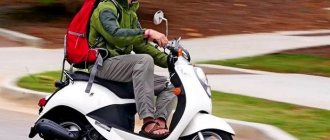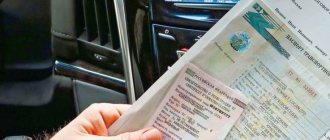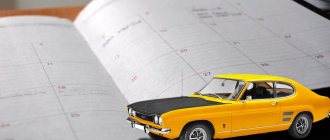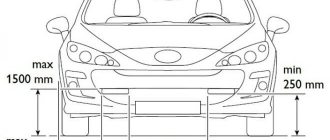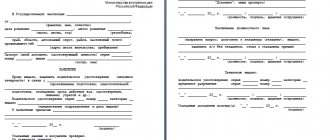Two years ago, changes were made to the clause “On permission to drive a vehicle”: the license for an automatic transmission will differ from the license for a manual transmission. According to experts, no serious differences have been made. Only an additional column has been added, indicating that the student was driving the car on an automatic and does not know how to handle mechanics.
Five years ago, driving licenses were also changed. For example, on the back of the rights there is a table of categories. Their number has increased compared to the old certificate. The valid period of the license also differs depending on the group in which the driver was trained.
What is the difference between the rights to a manual and an automatic with category “B”
The license issued for an automatic transmission does not differ externally from the manual license. The front surface is completely identical to the control unit on the manual transmission.
The only difference between the rights to the machine gun is the marking that supplements the rights of group “B”. A driver who has received this type of license is strictly prohibited from driving a car with a manual transmission installed.
Attention! These data are noted in the additional information of the Europrotkol after the accident.
What symbol represents the machine?
The back of the driver's license consists of a table. It lists all groups of vehicles existing in Russia. There are 7 main types of vehicles.
There are also subcategories. There are only 4 of them. Opposite the group for which the cadet is training, the start date of the driver’s license is placed, then the expiration date and a mark.
Read
Which gearbox is more reliable and better: robot, CVT or automatic?
This symbol is represented by two capital letters "AT". The machine is placed only opposite category “B” in column 14. It is located at the bottom of the document under the category table.
| Category | License date (12) | Rights expiration date (11) | Restrictions (12) |
| A | – | – | – |
| A1 | – | – | – |
| B | 15.09.2017 | 15.09.2027 | – |
| B1 | – | – | – |
| C | – | – | – |
| C1 | – | – | – |
14 AT
Having dealt with the differences between documents for a car with an automatic transmission and the place where the driver’s license indicates that the car owner has learned to drive a manual or automatic transmission, the reader will learn about the difficulties of driving a car with a manual transmission.
Categories and subcategories of the new ID
The categories of the new driver's license have been expanded into subcategories, and there are now sixteen of them.
Six big categories:
- A - motorcycles;
- B - passenger cars;
- C - trucks;
- D - buses;
- M - mopeds;
- T- ramways and trolleybuses.
Four subcategories: A1 , B1 , C1 , D1 .
Special subcategories for driving vehicles with a trailer: BE , CE , DE , C1E , D1E .
On the back of the driver's license they are located in the following order:
- A - motorcycles;
- A1 - light motorcycles with an engine from 50 to 125 cm3;
- B - passenger cars up to 3.5 tons, no more than eight seats, except for the driver;
- B1 - tricycles and quadricycles;
- C - trucks, including those with a light trailer;
- C1 - trucks up to 7.5 tons;
- D - buses, including those with a light trailer;
- D1 - minibuses with up to 16 seats;
- BE - passenger cars with a trailer, weighing over 750 kilograms;
- CE - category C trucks, with a trailer, weighing more than 750 kilograms;
- C1E - a truck of category C1, with a trailer, weighing more than 750 kilograms;
- DE - category D bus, with trailer 0.75 - 3.5 t;
- D1E - bus of category D1, with a trailer 0.75 - 3.5 tons;
- M - mopeds, scooters, and light quadricycles with an engine up to 50 cm3;
- Tm - tram;
- Tb - trolleybus.
At basic driver courses, categories and subcategories A, B and M are opened, of which the mark on training in cars with automatic transmission is relevant for category B.
What is the difference between training for a manual and automatic driving license?
Driving with a manual transmission requires increased care:
- while driving;
- at the traffic light;
- when performing maneuvers on turns, turns or in other cases.
It is necessary to be able to react in a timely manner when changing gears, first pressing the clutch pedal and then the gas. The driver must remember that first gear is engaged, then second, third, etc. There is no need to do this on an automatic transmission. The computer will decide everything for the driver.
Attention! Driving with a manual transmission requires good reaction, concentration and refined movements. Any confusion may lead to an accident.
Otherwise, training for automatic and manual transmission licenses is the same.
- Instructors teach traffic rules. Students study them and remember them. They take short tests on the material covered.
- They study the design of a vehicle with automatic and manual transmission.
- They are told about road accidents and what to do in the event of a road accident.
- The ability to provide first aid to a person involved in a traffic accident is studied.
- After the theoretical rules are memorized, the instructor begins training future drivers at the race track.
- And only after this, the driver, in the presence of an instructor, can go to a populated area and undergo city driving training.
Read
Basic modes and why you need an overdrive button on an automatic machine
If a student wants to study for category “C”, then he first undergoes training for “B”, and only then receives admission to “C”.
Basic rules for driving manually
Driving a car equipped with a manual transmission requires full concentration from the driver. You have to constantly use both legs and both hands to change gears when accelerating and braking a car in a manual transmission. Squeeze the clutch with your left foot, press on the gas or brake with your right. The left hand should always be on the steering wheel, and the right hand should be periodically used to select the speed with the gearshift knob.
Unlike an automatic transmission, a manual transmission needs to be switched at a certain moment for the car to accelerate smoothly. Each speed has its own range of engine speed.
The device that shows the corresponding mark on the scale is called a tachometer. It is located in the center of the dashboard.
Read
Technical characteristics of automatic transmissions, types and their differences from each other
Starting a car with the clutch depressed
Starting the engine implies the start of operation of a complex mechanism that has cooled down during parking and has not been subject to constant lubrication. Rotating the crankshaft, which is connected to the transmission shaft, is not an easy task for a manual starter. When the clutch is depressed, it is easier for the engine to start, since the connection between the two units is disconnected.
On some models of modern cars with “mechanics”, the engine starts only when the clutch pedal is pressed. Otherwise the car will not start. This approach ensures long-term operation of the motor and its trouble-free operation.
How to get moving
The stumbling block for a driver who decides to switch from an automatic to a manual is the process of starting to move. There are no difficulties with this on an automatic machine. Even experienced motorists can accidentally stall at a traffic light by releasing the clutch too quickly. The engine speed at which the car starts to move may vary. It all depends on the settings of the clutch and ignition. But the algorithm of actions for all manual boxes is the same:
- Start the engine, making sure that the manual transmission lever is in the “neutral” position.
- Press the clutch pedal all the way with your left foot.
- Move the gearshift knob to the first speed position.
- Smoothly depress the clutch pedal and simultaneously press the gas pedal with your right foot.
- After waiting until the car starts moving, you can release the clutch pedal all the way.
- If the car begins to jerk and stall, quickly press the clutch again and begin the process of moving away.
Read
Automatic transmission vibration when shifting into gear
To practice this exercise, it is recommended to repeat the entire algorithm several times. Over time, the driver gets used to the operation of the “mechanics” and the engine, and he manages to get underway the first time.
How to move off with the handbrake
One of the difficult exercises practiced in a driving school is the so-called “overpass” - starting a car with the handbrake while on an inclined surface. For those who are planning to switch from an automatic to a manual, it will be unusual to use the handbrake when driving uphill. On a car equipped with an automatic transmission, any movement begins with releasing the brake pedal. The exercise consists of several sequential actions:
- The car drives up a hill and stops.
- To park the car on a slope, apply the handbrake, then release the brake pedal.
- The car may remain in this position for some time, for example, while standing at a traffic light or in a traffic jam.
- You need to start moving so that the vehicle does not roll back. To do this, you need to reproduce all the steps for starting off.
- At the moment when the tachometer needle reaches 2000 - 3000 rpm, the car is ready to move, but the handbrake holds it. At this time it is turned off, and the car immediately moves forward without rolling back.
This method of stopping on an inclined surface can be carried out on a car with a working handbrake. The owner of a manual vehicle must always monitor the condition of all mechanisms and devices responsible for driving safety.
Read
Automatic transmission gear selector: types, disassembly and repair
When to shift to neutral on a manual transmission
There are many myths about when you need to engage neutral gear on a manual transmission and whether you can coast. First of all, “neutral” is intended for towing a car with both “mechanics” and “automatic”. This transmission breaks the connection between the engine and the gearbox. Let's look at the main cases of using neutral gear, their pros and cons.
| Cases of turning on “neutral” on a manual transmission | pros | Minuses |
| Coasting down a hill or towards a traffic light | There is a slight fuel saving, there is no need to depress the clutch when braking | The driver is not able to quickly change the trajectory of the vehicle in the event of an emergency |
| Short stops in traffic jams and traffic lights | The driver can rest without pressing the pedals | No cons |
| Long-term parking or parking | When starting the engine, the car will not jerk forward or backward as if a gear was selected | Without leaving the car at speed, you have to use the handbrake. If the parking brake cable is stretched, the car may roll downhill. |
Parking at speed
Driving the car with an automatic transmission, the owner does not have any difficulty choosing before parking. The automatic transmission has a special “parking” mode for this purpose. With a manual transmission, one of the options to leave the vehicle in the parking lot is to engage a gear.
Motorists who choose to park at speed recall the unreliability of the handbrake, which tends to fail over time. Also, owners of manual cars are indignant about frozen brake pads as a result of sudden temperature changes.
The disadvantages of parking with a manual gear engaged include the risk of forgetting about it and starting the engine without pressing the clutch. A jerking car may hit another car parked nearby.
Parking with handbrake
The classic way to park a manual car is to use the handbrake. The handbrake sets the brake pads in motion, which lock the wheel disc, preventing it from turning. If the parking brake cable is working properly and the weather is warm outside, this type of parking is ideal.
Read
What are automatic transmission clutches and how to replace them yourself
If the circumstances are unfortunate, the cable may be stretched and the car will begin to roll downhill. If the temperature changes from minus to plus or when snow gets in, the brake pads may freeze to the discs and the car will not be able to move.
Engine braking
Unlike an automatic, where there is only one way to brake, a manual has two:
- Pressing the brake and clutch pedals at the same time. This method allows you to brake smoothly and quickly without changing gears. It is most often used by drivers.
- Engine braking. This method is effective on slippery or snowy roads, when sudden braking can lead to skidding. The driver engages a lower gear, causing the engine to reduce traction and the car to brake. This braking option may be the only one in the event of brake failure.
What is the best way to study and what is the best way to pass the exam?
Instructors advise training on a manual transmission. The more attentive a road user is, the fewer accidents he will commit. Experts say learning automatically gives a false sense of security. But a computer will not be able to react faster than a human in some situations.
Mechanical engineering requires a person to take a longer course. Skills must be honed. But the positive aspects of learning to drive a manual transmission are undeniable.
| Name | Rights to manual transmission | Automatic transmission rights |
| Driving a car with manual and automatic transmission | Can | No, only automatic |
| Training for category "C" | Can | Not possible (you must first pass your manual transmission license) |
| Control of vehicle speed dynamics | Available | Impossible (everything is controlled by the computer) |
| Completing the “Overpass” exam | Present | Absent |
But, the permission to choose to hand over your license only to a manual or only to an automatic was still established by the law of the Russian Federation of 2013. Therefore, now any student has the right to choose which vehicle he will be allowed to drive.
When driving a car with an automatic transmission, there are a number of subtleties:
- The automatic transmission warms up regardless of weather conditions. A cold box will not be able to quickly process the data received from the on-board computer and will lead to the possibility of an accident, especially on slippery roads. In winter, experienced car owners recommend warming up the machine to 60 degrees Celsius, and in summer it will take three minutes to warm up to this temperature;
- The car should be started from the position of the gear selector “Parking” or “Neutral”. The car will not start from other positions;
- Before driving, move the gearbox handle to position “D”.
Read
Which automatic transmission is the most reliable and best, rating of automatic transmissions
If the driver is driving a car with an automatic transmission, then the left foot should be placed on a special instep. Since such cars have only two pedals.
Is it possible to take your license automatically?
Future drivers are interested in which gearbox they should use to take the test. The law establishes the following rules:
- If a student gains driving skills with a manual transmission, then he must take a manual transmission license test. It is not recommended to undergo training on the machine;
- If a student gains driving skills with an automatic transmission, then the exams must be taken by an instructor using an automatic transmission.
Before choosing which course of study to take, a new cadet should consider whether it will turn out that the student will have to drive a car with an automatic transmission. Or maybe he wants to get the rights to group “C”.
Is it possible to drive an automatic if you passed your manual license?
The license that a driver receives after completing mechanics training is universal. These cadets can drive any passenger vehicle. Those who have learned to drive a car with an automatic transmission can drive a car with an automatic transmission, a CVT or a robot.
According to statistics, the majority of women receive a driver's license to drive a vehicle with an automatic transmission. Studying and passing exams for a machine gun license has a short time frame and low cost.
School programs change frequently. Therefore, upon admission, the cadet must learn all the nuances. Students can choose the brand of car in which they prefer to take exams or study.
Read
How to distinguish and what is better DSG or automatic
If a driver who has received a permit to drive a car with an automatic transmission gets behind the wheel of a car with a manual transmission, he will pay a fine in accordance with the law of the Russian Federation in an amount of up to 15,000 rubles.
Is it possible to drive a car with a manual transmission if you passed an automatic transmission for your license?
With a license that specifies an automatic, driving a manual transmission is strictly prohibited. This restriction is regulated by provision 12.7 of the current traffic rules, and is regarded as driving a car of a certain category without the appropriate permit. For violation of this article, the driver may be subject to administrative sanctions in the form of a fine of 5-20 thousand rubles (the difference in the amount will depend on the conditions under which the offense was committed and whether it was repeated after the first protocol issued).
Of course, in practice this whole situation looks a little different. Indeed, in order to replace a license marked AT (a box with an automatic switch) with a document without restrictions, a citizen will need to not only retake the driving test, but also pay for additional courses. Therefore, more often than not, people learn to drive a car with a manual transmission on their own, and most traffic police officers turn a blind eye to such an error.
The procedure for obtaining the right to an automatic and manual transmission
Attention! Any citizen of the Russian Federation who is 16 years old at the time the license is issued can drive mopeds and motorcycles. Categories A, B, C open after reaching adulthood. A group of licenses to drive a car with a trailer, trucks, buses is issued to students who have turned 21 years old. An educational institution will not accept courses if the student has not reached the required age to obtain a tertiary education in one of the groups.
To become a full-fledged owner of a driver’s license for a car with an automatic transmission or manual transmission, a cadet must:
- learn theoretical information;
- undergo practical training with an instructor;
- pass a medical examination;
- bring the documents that are required;
- successfully pass exams;
- obtain a driving license.
Documents you will need:
- application for the issuance of rights;
- passport identification;
- certificate of registration at the place of residence;
- medical certificate U-89;
- certificate of completion of training in driving programs;
- photo 3x4;
- receipt of payment for exams.
Attention! The cost of a temporary driving permit is 500 rubles, and the state fee for issuing a license costs 2,000 rubles.
The license to drive a vehicle with an automatic or manual transmission is issued directly to those who have completed training. All information about this person is entered into a computer and stored electronically on the traffic police servers.
Cars for training cadets with disabilities are equipped with special equipment. This is done to speed up the production of rights.
Read
Purpose of the Shift Lock release button on an automatic transmission
To obtain a medical certificate, you must visit the following doctors:
- otolaryngologist;
- ophthalmologist. If the future driver has a slight visual impairment, then this will definitely appear on the driver’s license. It, like the symbol “AT”, will be recorded in the fourteenth line. The visually impaired driver symbol is displayed as GCL;
- neurologist;
- do an encephalography;
- donate blood and urine for analysis;
- expert in narcology. If the doctor discovers that the future driver uses even light drugs, then he may be suspended from training for any category of license, not just automatic or manual;
- therapist. He gives an opinion on the degree of suitability to study for a license.
The theoretical part lasts 136 hours, the practical part – 56 hours for passenger vehicles and light-duty trucks.
If the future driver studied independently and wants to take the exams, then he needs to submit an application electronically on the State Services website or to the traffic police. If a cadet nevertheless decides to study at a vehicle driving school, and he does not have enough hours to gain solid skills, then he can turn to the instructors for additional time.
Driving school confirmation
Driving school students who took their documents in hand after completing their training in 2021, many received a certificate confirming their training in a set of documents. Let’s take a closer look at the documents issued by the driving school.
After the student has successfully completed the driving school, he receives a Certificate of Completion from the driving school, this is the most important document, similar to any diploma of secondary specialized education, also in the driving school, a set of documents can issue a Medical Certificate if the student has passed a medical examination on the basis of a medical center collaborating with a driving school. A driver's card is also issued, but in essence it has no meaning. In order to get to the traffic police exams on your own, you need to provide the following documents:
- Passport
- Medical certificate (at the moment, in 2021, medical certificates are valid for one year, please note that your certificate is valid)
- Driving school completion certificate
- Driver's license (if available, for example with other open categories)
- Paid receipt for issuing a driver's license
- Certificate confirming training (if you take the traffic police exams yourself, in another city)
- Certificate confirming the issuance of a medical certificate (if you take the traffic police exams yourself, in another city)
If you have collected your driving school graduation documents and are going to take exams at the traffic police in another city, you will definitely need a certificate confirming your training at the driving school and a similar confirmation certificate from the medical center where you received your medical certificate. A certificate confirming training and a medical certificate will be required from you only if you submit documents to the traffic police in a city other than the one where you studied at the driving school, the same with a medical certificate. In this case, there are two ways to develop the situation:
- The traffic police can accept the confirmation certificates that were issued to you at the driving school and at the medical center and allow you to take the exams.
- The traffic police may allow you to take the exams, but will not issue you a driver's license until they receive an official response (confirmation) from the driving school and medical center, or will not even allow you to take the exams.
Considering the second option, you will lose a lot of time, the amount will depend on a combination of various circumstances. First, GAI will generate a confirmation request on company letterhead, one to the driving school, the other to the medical center, assigning them outgoing numbers. Such requests are sent by Russian Post. Depending on how far the cities are from each other, where you studied and passed the medical examination, and where you decided to take your license, you can roughly calculate the time it will take for the letter to be in transit. It turns out that such a letter will travel from the city where the request was sent from the traffic police, to the location of the driving school or medical center (or both) and back to the traffic police. On average, students wait at least 1-2 months for answers to such requests, and some students do not wait for them at all. It’s all due to the human factor; at first it can take several days for the traffic police to formulate a request, and if you came right before the weekend, you’ve automatically lost a few more days. At the same time, traffic police officers are always busy with work and that is why they cannot immediately respond by making a request on the day the student applies, although this happens most often, and they do it every day. Then the Russian Post, we cannot describe what is happening there, but since the letter is not first class and not with courier delivery, so it is impossible to track it and it can also get lost. Due to these circumstances, the process of passing a license increases by an average of 1-2 months. It is worth noting that in Moscow there are always a lot of people who want to take the exams at the traffic police on their own, and therefore it is possible to get to the site after successfully passing the theory only after 10-14 days, in the order of an already formed queue, the same is with the city. In cases where you were trained not in Moscow, but by coincidence you are taking the traffic police exams here, we advise you to join a driving school and take it in an organized manner.
